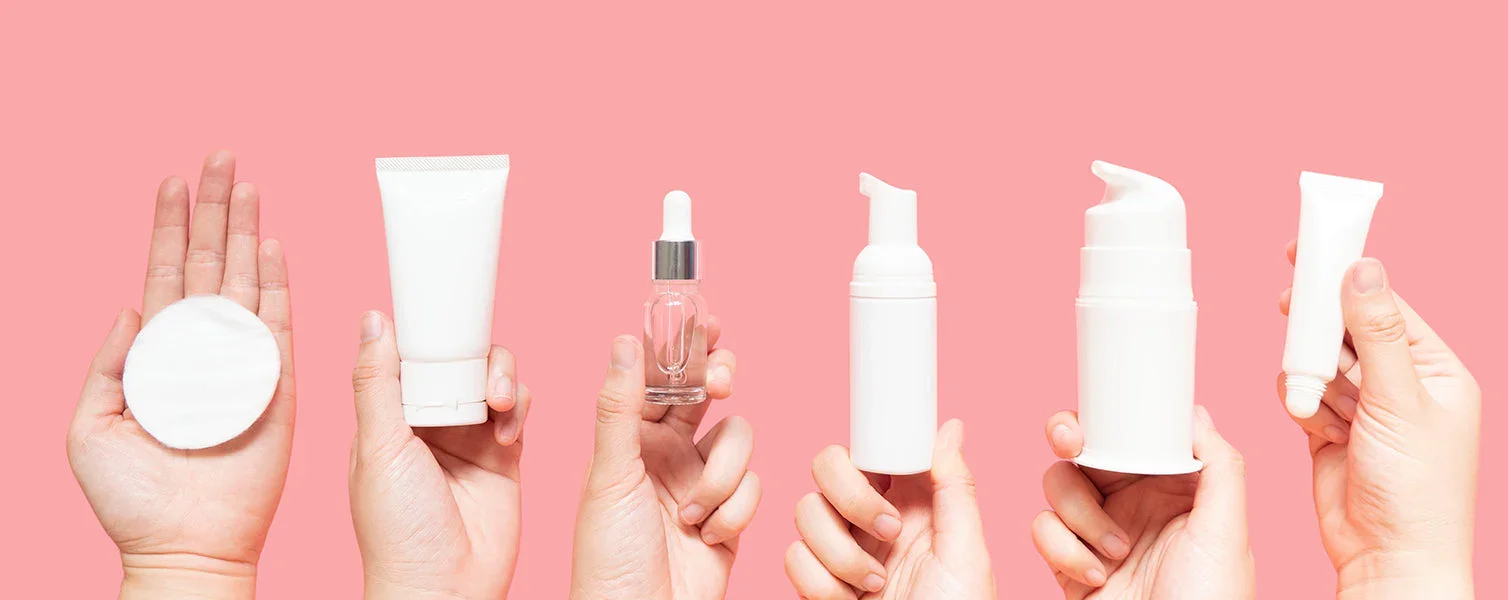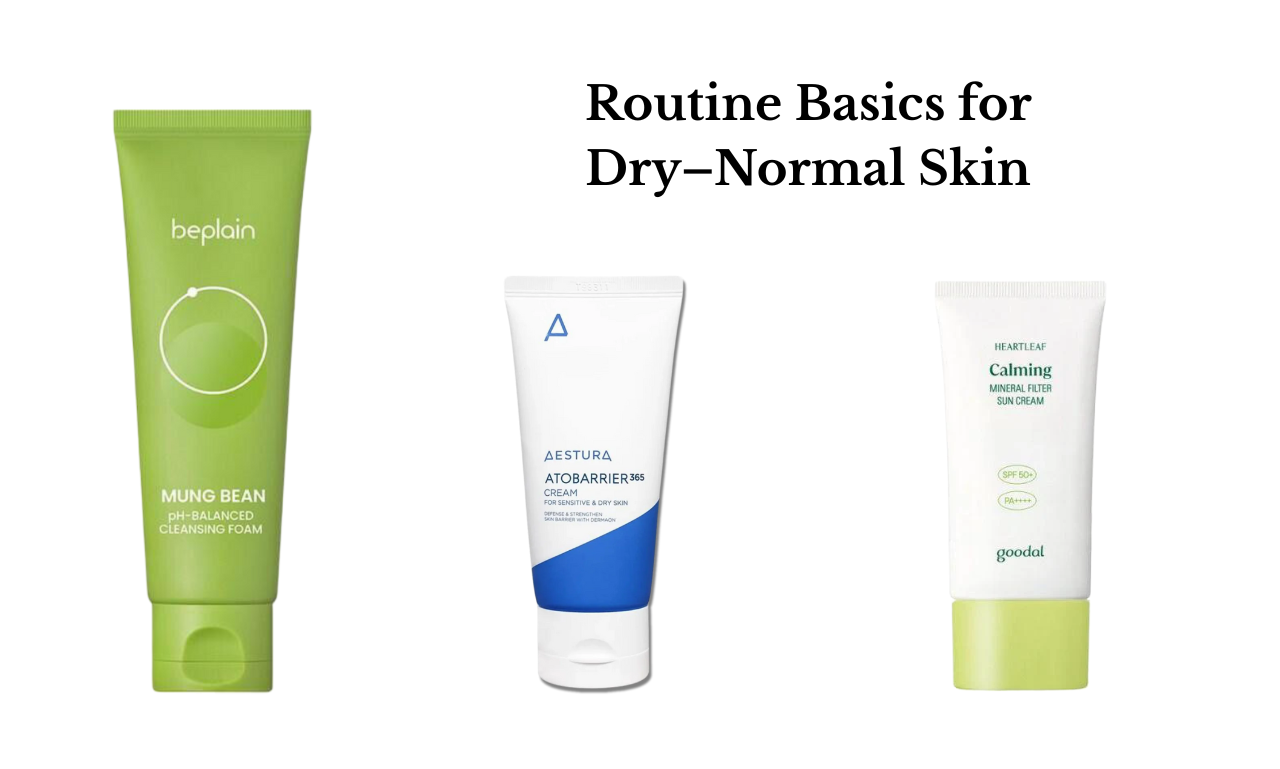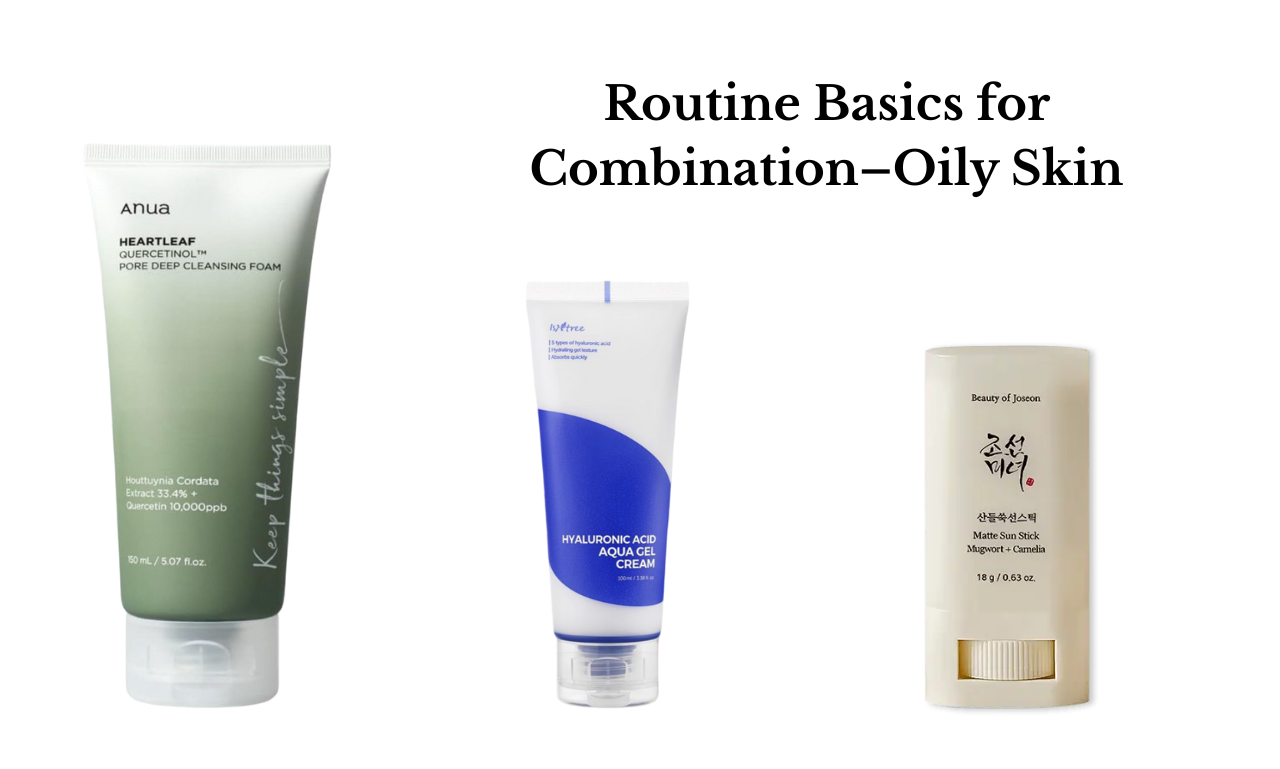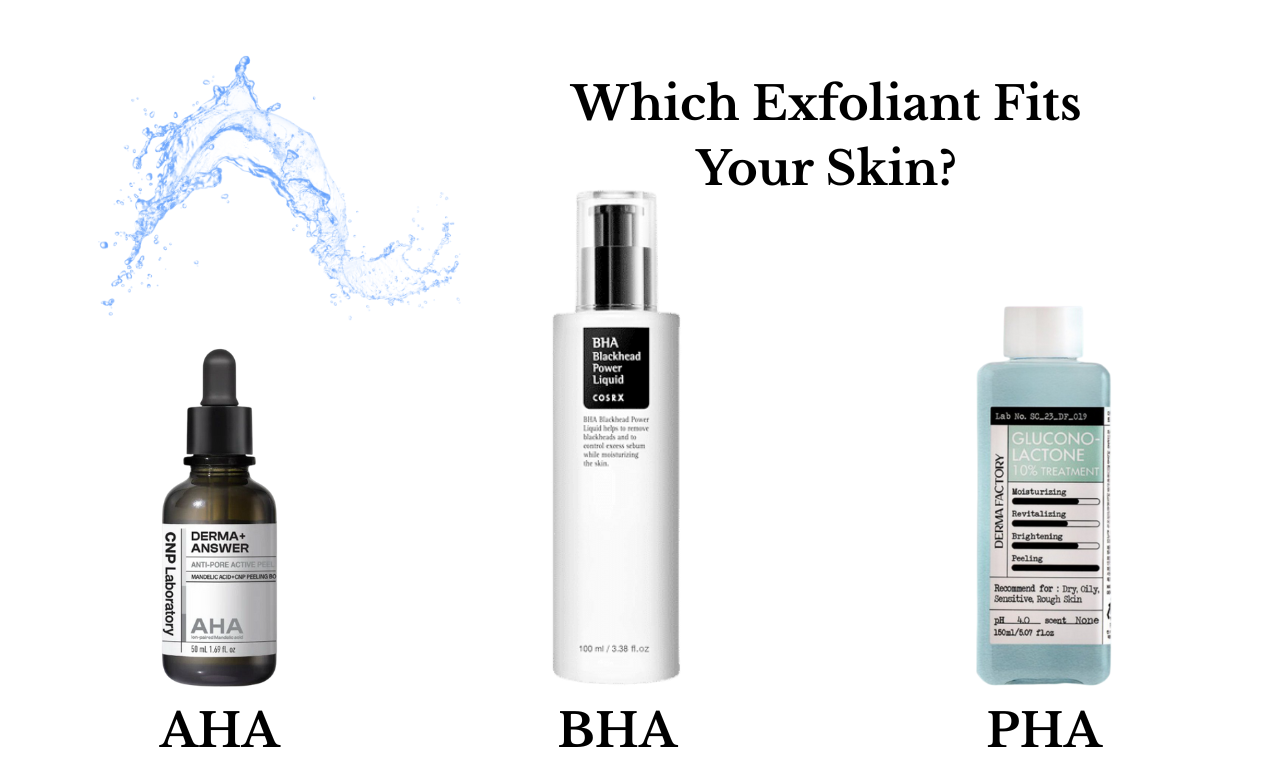Skincare Basics: Where to Start for Beginners
If you’re new to skincare, it’s totally normal to feel a bit overwhelmed by all the products, steps, and skincare jargon out there. Korean skincare gets a lot of love for its results, but sometimes all those extra steps can make things confusing.
That’s why starting simple is the best way to go. In this article, I’ll share easy, practical tips to help you build a skincare routine that works for you—whether you’re just getting started or want to refresh your routine with confidence.
Table of Contents:
Identify Your Skin Type
Understand Your Skin Concerns
Basic Skincare: Building Your Routine by Skin Type
Targeted Treatments: Choosing Active Ingredients for Your Concerns
Extras and Optional Add-Ons for Your Routine
Identify Your Skin Type
Before choosing any products, it’s essential to figure out your skin type first! Your skin type basically shows where your skin falls on the dry-to-oily scale, and it’s important because it helps determine the texture and formulation of your basic skincare products like cleansers, moisturizers, and sunscreens. There are four main skin types:
Dry: Your skin feels tight, may sometimes flake in patches.
Normal: Your skin feels balanced — not dry or oily — and looks smooth and comfortable.
Combination: Some areas, usually the T-zone, are oily, while others are dry.
Oily: Most of your skin tends to be oily and shiny.
According to the American Academy of Dermatology (AAD) and other experts, sensitive skin is often considered a fifth basic skin type. However, it’s important to understand that sensitivity is actually a skin condition, not a skin type. Any of the four main skin types can experience sensitivity, which means irritation, redness, or discomfort.
Understand Your Skin Concerns
When we talk about skin concerns, we mean things like wrinkles and fine lines, breakouts, or conditions like rosacea. If you’re young and fortunate, you might not have any major worries yet—and that’s great! But it’s totally normal to have more than one concern at once. Maybe you’re dealing with acne but also want to start thinking about anti-aging.
The key is to figure out what matters most to you right now. What’s your top priority? And if you have others, that’s okay too—just know which ones come next. Knowing your main concerns will help you choose the right active ingredients and powerful treatments—like exfoliants, serums, or boosters—that truly make a difference for your skin.
Basic Skincare: Building Your Routine by Skin Type
When it comes to skincare, three products form the foundation of any effective routine: a cleanser, a moisturizer, and sunscreen. These three are the essentials you can’t skip if you want healthy, glowing skin.
Here’s a simple routine to start with:
Morning: Cleanse your skin, follow with moisturizer, and finish with sunscreen to protect your skin throughout the day.
Evening: Cleanse and moisturize to keep your skin balanced and nourished.
Choosing the right products mostly depends on your skin type, but your specific skin concerns also play a role—many products are carefully formulated to address both your skin type and your specific concerns, so you get the right balance of care.
Some tips to help you choose the right fit:
For dry to normal skin:
Choose creamy or oil-based cleansers that don’t foam too much
Use rich moisturizers to keep your skin hydrated
Apply gentle sunscreen for daily protection
For combination to oily skin:
Avoid harsh cleansers that strip your skin and cause dryness
Opt for lightweight, gel-like moisturizers
Use mattifying sunscreens to control shine and keep your skin comfortable
Targeted Treatments: Choosing Active Ingredients for Your Concerns
Now it’s time to take your basic routine to the next level and make it truly personalized. High-potency products with active ingredients are what can make the biggest difference for specific skin concerns. Even if you don’t have any major skin issues but want to give your skin the best care possible, adding these products can boost your routine.
There are two main categories to focus on here: at-home chemical exfoliants and serums (also known as boosters or treatments).
At-Home Chemical Exfoliants
No matter what your skin concerns are, a well-chosen chemical exfoliant can be a game-changer. These are far better than physical scrubs because they remove dead skin cells without causing irritation or micro-tears. Plus, depending on the type of acid, they can offer additional benefits beyond exfoliation.
Quick Guide to Choosing the Right Exfoliant:
Most chemical exfoliants list the type and concentration of acid right in their name, which helps you narrow down the best options for your skin:
Anti-aging focus / Uneven skin / Normal to dry skin: Look for AHAs. Around 5% is considered gentle, 8% moderate, and 10–12% is quite strong.
Problematic skin (blackheads, acne) / Combination to oily skin: BHAs and mandelic acid work well here. For liquid formulas, a 2% BHA exfoliant is a good place to start, and if you prefer gels, a 2% BHA gel can be effective too.
Sensitive or redness-prone skin: PHAs and BHAs in creamier lotion textures are ideal. Look for products labeled as lotions with 1–2% acid concentration, or exfoliants combining both PHA and BHA.
How and When to Use Them in Your Routine:
The most important thing about exfoliants is that usage frequency is very individual. Most products (except stronger AHAs of 10% or more) are typically used once a day. If you have sensitive skin, every other day or 2–3 times a week might be better—even if the product says daily use.
If you add a chemical exfoliant to your basic routine, it could look like this:
Morning: Cleanser → Moisturizer → Sunscreen
Evening: Cleanser → Exfoliant* → Moisturizer
*Exfoliation doesn’t need to happen every day — adjust frequency based on how your skin responds.
When choosing your exfoliant, pay attention to the type and amount of acid listed, as well as the product texture: liquid (fluid), gel, or lotion (light creamy).
Serums, Boosters, and Treatments
These three terms basically mean the same thing: high-potency products that focus on either a specific skin concern or a key active ingredient that often benefits multiple concerns. With a few exceptions, most serums and treatments work for all skin types, and your choice should mainly depend on your skin concerns.
Quick Guide to Choosing the Right Actives:
Here’s a helpful list of key active ingredients to consider based on your skin concerns:
Anti-aging (wrinkles, firmness, skin health):
Prevention: Antioxidants help protect your skin from damage caused by free radicals.
Correction: Retinol, Vitamin C, and peptides support your skin’s natural collagen production.
Acne-prone, blemished, or enlarged pores:
Azelaic acid, niacinamide, and retinol are effective ingredients for calming inflammation and improving skin texture.
Sensitive or redness-prone skin:
Look for anti-inflammatory ingredients and centella, which can soothe and calm irritated skin.
Hyperpigmentation:
Vitamin C and niacinamide help reduce melanin production to fade dark spots, while retinol speeds up cell turnover to reveal brighter skin.
Dehydration:
Hyaluronic acid and other humectants draw moisture into the skin for long-lasting hydration.
How and When to Use Serums in Your Routine:
Most serums can be used morning or evening, once or twice daily, depending on your preference. Retinol serums are best used in the evening, while antioxidant serums are often recommended for morning use.
You can layer multiple serums at once—just follow the “lightest to heaviest” texture rule when applying. However, using more than three serums at a time isn’t usually necessary; sometimes less is more.
If you add one or more serums to your basic routine plus exfoliation, your skincare might look like this:
Morning: Cleanser → Serum(s) → Moisturizer → Sunscreen
Evening: Cleanser → Exfoliant* → Serum(s) → Moisturizer
*Exfoliation doesn’t need to happen daily—adjust based on how your skin responds.
Eye Care: Serums and Creams for the Delicate Eye Area
The skin around your eyes is thinner and more delicate than the rest of your face, so it deserves special care. High-potency serums and creams designed specifically for the eye area target common concerns like dark circles, puffiness, and fine lines (often called crow’s feet).
These products contain targeted ingredients that help brighten, reduce swelling, and improve elasticity without irritating this sensitive area. Popular actives include caffeine to reduce puffiness, peptides to support collagen, antioxidants to protect against damage, and hyaluronic acid to hydrate and plump the skin.
Using an eye serum or cream consistently can make a noticeable difference in the appearance and health of your eye area, helping you look more refreshed and awake. Remember to apply these products gently—use your ring finger to lightly pat the product around the orbital bone, avoiding pulling or rubbing the delicate skin.
Extras and Optional Add-Ons for Your Routine
These are products that aren’t essential basics or superstar problem-solvers, but if you enjoy skincare, love multi-step routines, or consider yourself a bit of a skincare maximalist, they can make your routine feel more complete and luxurious.
Toners and Mists
These lightweight, liquid products help soothe and hydrate your skin, and depending on your skin type, they may offer additional benefits. Use them right after cleansing, before serums—or if your exfoliant is liquid, apply the toner after the exfoliant.Here’s how your routine might look with a toner included:
Morning: Cleanser → Toner/Mist → Serum(s) → Moisturizer → Sunscreen
Evening: Cleanser → Liquid Exfoliant* → Toner/Mist → Serum(s) → Moisturizer
*Exfoliation frequency varies—adjust to your skin’s needs. If your exfoliant isn’t liquid, apply toner first, then exfoliant.
Primers and Finishers
These products help even out and blur minor skin imperfections, making foundation apply more smoothly and last longer. If you wear foundation, experimenting with primers is worth it, but even without foundation, primers can create a subtle “photoshop in a tube” effect.
Use primers in the morning, directly under foundation and over sunscreen. If you can, wait 10–15 minutes after applying sunscreen before layering primer and foundation on top—this helps sunscreen absorb fully and work effectively.
Here’s what your routine might look like with primer added:
Morning: Cleanser → Toner/Mist → Serum(s) → Moisturizer → Sunscreen → Primer
Evening: Cleanser → Liquid Exfoliant* → Toner/Mist → Serum(s) → Moisturizer
*Exfoliation frequency varies—adjust as needed. If your exfoliant isn’t liquid, use toner first, then exfoliant.
Masks
Masks are a bit of a wildcard—they aren’t for daily use, and most need to be rinsed off. If you love masks, always follow the product’s instructions carefully. For rinse-off masks, feel free to continue with your regular routine afterward. Sheet masks are a beloved part of Korean skincare routines and should be applied just before your moisturizer to deeply hydrate and nourish your skin.For leave-on masks, apply them as the last step in your routine.
Takeaway
Building a skincare routine doesn’t have to be complicated. Start with the basics—a gentle cleanser, a moisturizer, and sunscreen—and then add targeted treatments and extras as needed based on your skin type and concerns. Remember, consistency is key, and with a little patience, you’ll see your skin become healthier and more radiant.






